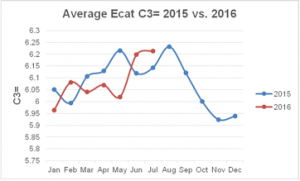In a recent Q&A with Alexis S. Shackelford, Technical Marketing Specialist, BASF, she mentioned FCC catalyst’s role in the continuous effort to optimize the fluidized catalytic cracker (FCC) for maximum profit. Operational changes including cut-point adjustments are quick ways to manipulate produced yields, and can be done in hours. Catalyst changes on the other hand take a few months to see the full effects due to changeover.
Against this backdrop, Shackelford responded to the following question submitted by Refinery Operations: “Concerning the current economics of gasoline surpluses, do you see changes to FCC catalyst formulations in pursuit of other opportunity markets, such as propylene?”

Fig-1. Global Average ECat gasoline yield has decreased to 46 wt%
Shackelford:The answer is yes, but these are long-term trends versus seasonal. BASF maintains a database of equilibrium catalysts (Ecat), containing data from over 200 units worldwide. Benchmarking these unit’s Ecat since 2002 through the end of 2015, the average Ecat gasoline yield across the globe (shown as the black dashed line in Figure 1) has decreased from approximately 48wt% to approximately 46wt%.
However, in the past few years the global gasoline yield has been flat, and North America shows a slight increase in Figure 1. The C3= (or propylene) yield shown in Figure 2 has significantly increased over 1wt% globally. Most of that increase was from 2002 – 2011, with the past few years slowing down on average. Some regions are still showing an increase, especially the Europe, Middle East and Africa region where several large-scale FCC units designed for maximum propylene are located.

Fig 2. Increased propylene yield
Along with higher propylene yields, refiners are also making more C4s for alkylation, which increases the refinery gasoline octane pool (Figure 3).

Fig 3. Increasing C4 production for alkylation
Comparing Ecat propylene yield from 2015 to 2016 in Figure 4, this summer shows similar trends to 2015 for propylene. The summer season shows propylene peaking, but at about the same level as 2015.
In consideration of FCC distillate or LCO yield (Figure 5), while global demand for distillate outpaces that of gasoline, the economics at the FCC still favor higher conversion over distillate yield.

Fig 5. FCC LCO yield
In summary, refiners have been changing catalyst formulations to favor C3s and C4s over gasoline for the last decade. The past few years shows this trend slowing down, with 2016 not outpacing 2015 for propylene. There are regional demands for distillate, but overall there is no clear trend of increased catalyst selectivity for distillate over the past 10 years globally.








Leave a Reply
You must be logged in to post a comment.